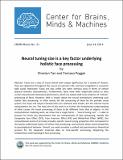| dc.contributor.author | Tan, Cheston | |
| dc.contributor.author | Poggio, Tomaso | |
| dc.date.accessioned | 2015-12-10T23:47:39Z | |
| dc.date.available | 2015-12-10T23:47:39Z | |
| dc.date.issued | 2014-06-14 | |
| dc.identifier.uri | http://hdl.handle.net/1721.1/100185 | |
| dc.description.abstract | Faces are a class of visual stimuli with unique significance, for a variety of reasons. They are ubiquitous throughout the course of a person’s life, and face recognition is crucial for daily social interaction. Faces are also unlike any other stimulus class in terms of certain physical stimulus characteristics. Furthermore, faces have been empirically found to elicit certain characteristic behavioral phenomena, which are widely held to be evidence of “holistic” processing of faces. However, little is known about the neural mechanisms underlying such holistic face processing. In other words, for the processing of faces by the primate visual system, the input and output characteristics are relatively well known, but the internal neural computations are not. The main aim of this work is to further the fundamental understanding of what causes the visual processing of faces to be different from that of objects. In this computational modeling work, we show that a single factor – “neural tuning size” – is able to account for three key phenomena that are characteristic of face processing, namely the Composite Face Effect (CFE), Face Inversion Effect (FIE) and Whole ‐ Part Effect (WPE). Our computational proof ‐ of ‐ principle provides specific neural tuning properties that correspond to the poorly ‐ understood notion of holistic face processing, and connects these neural properties to psychophysical behavior. Overall, our work provides a unified and parsimonious theoretical account for the disparate empirical data on face ‐ specific processing, deepening the fundamental understanding of face processing. | en_US |
| dc.description.sponsorship | This work was supported by the Center for Brains, Minds and Machines (CBMM), funded by NSF STC award CCF‐1231216. | en_US |
| dc.language.iso | en_US | en_US |
| dc.publisher | Center for Brains, Minds and Machines (CBMM), arXiv | en_US |
| dc.relation.ispartofseries | CBMM Memo Series;021 | |
| dc.rights | Attribution-NonCommercial 3.0 United States | * |
| dc.rights.uri | http://creativecommons.org/licenses/by-nc/3.0/us/ | * |
| dc.subject | Face recognition | en_US |
| dc.subject | Computer vision | en_US |
| dc.subject | Artificial Intelligence | en_US |
| dc.title | Neural tuning size is a key factor underlying holistic face processing | en_US |
| dc.type | Technical Report | en_US |
| dc.type | Working Paper | en_US |
| dc.type | Other | en_US |
| dc.identifier.citation | arXiv:1406.3793 | en_US |
